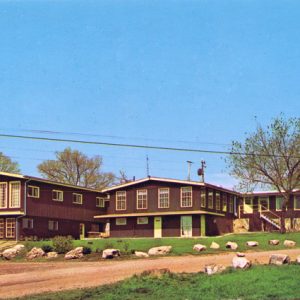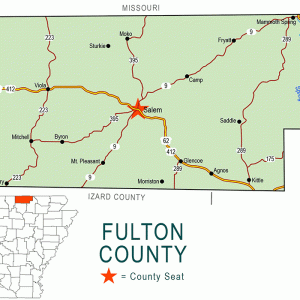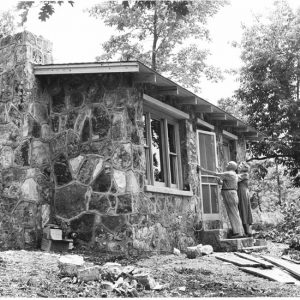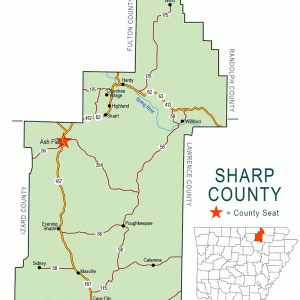calsfoundation@cals.org
Cherokee Village (Sharp and Fulton Counties)
| Latitude and Longitude: | 36°17’52”N 091°30’57”W |
| Elevation: | 633 feet |
| Area: | 20.43 square miles (2020 Census) |
| Population: | 4,780 (2020 Census) |
| Incorporation Date: | January 1998 |
Historical Population as per the U.S. Census:
|
1810 |
1820 |
1830 |
1840 |
1850 |
1860 |
1870 |
1880 |
1890 |
1900 |
|
– |
– |
– |
– |
– |
– |
– |
– |
– |
– |
|
1910 |
1920 |
1930 |
1940 |
1950 |
1960 |
1970 |
1980 |
1990 |
2000 |
|
– |
– |
– |
– |
– |
– |
– |
4,058 |
4,416 |
4,648 |
|
2010 |
2020 |
|
|
|
|
|
|
|
|
|
4,671 |
4,780 |
|
|
|
|
|
|
|
A retirement community in northeastern Arkansas, Cherokee Village was founded in 1954. Started as a 2,400-acre summer resort in the vein of the Wahpeton Inn at Hardy (Sharp County), Cherokee Village became the state’s leading retirement community by the early 1960s.
In 1948, West Memphis (Crittenden County) developer John A. Cooper Sr. purchased 400 acres along the south bank of the Spring River near the mouth of Otter Creek. Christening the property Otter Creek Ranch, Cooper used the land as a family summer retreat for several years. After purchasing additional land, Cooper formed the Cherokee Village Development Company in 1953, divided the property into lots, and constructed individual homes. When the property was formally opened in June 1955, Governor Orval Faubus declared it to be “the coming Mecca of the Ozarks.”
By 1961, retirees from across the United States relocated to the Spring River area, transforming Cherokee Village into a popular retirement center. Cooper’s development company opened Bella Vista (Benton County) in northwest Arkansas in 1967 and, three years later, completed Hot Springs Village (Garland and Saline Counties). The construction of these three communities (Bella Vista Village, Cherokee Village, and Hot Springs Village) established Arkansas as one of the most important retirement destinations in the United States.
In addition to homes, the Cherokee Village Development Company added two golf courses, seven lakes, three recreation centers, 350 miles of roads, and a water system for its residents.
Less than ten years after the town’s founding, Cherokee Village had grown so much that additional land was necessary to satisfy the demand for new homes. However, adjoining land was occupied by the Memphis Boy Scout Council’s summer camp, Kia Kima. In 1964, Cooper approached the Boy Scouts and offered to give them a larger tract of land on the south fork of the Spring River in exchange for their property. The Memphis youth organization relented after Cooper agreed to construct several new buildings on the Boy Scouts’ new property. The Kia Kima trade and other land purchases expanded Cherokee Village to 13,500 acres by 1980.
When Cherokee Village was established, no provision had been made for residents to share the costs of maintaining the roads and recreational facilities operated by the development corporation. Not wanting to fund these services exclusively, the corporation’s board of directors suggested the creation of a suburban improvement district in 1968. The state allowed for the creation of these districts under the Arkansas State Improvement District Act of 1941 to provide public services, such as road maintenance and recreational facilities, without the formality of incorporation. In order to create an improvement district, citizens were required to seek approval from the local circuit court. The following year, the Cherokee Village Country Club recommended the creation of an improvement district to provide a fire department and maintain recreational facilities and streets. Some 1,100 property owners petitioned the circuit court for permission to establish the district, but not all Cherokee Village residents approved of the plan.
Several residents formed the Property Owners Protective Association to block the circuit court petition. In their lawsuit, the members of the Property Owners Protective Association argued that the plan was unconstitutional because it gave the government’s taxation power to a private corporation. Meanwhile, those who supported the creation of the improvement district formed the Property Owners Association. The local circuit court judge rejected the Property Owners Protective Association suit, declaring their argument invalid because the proposed suburban improvement district would levy taxes, not the development corporation. Despite the setback, disgruntled residents continued to challenge the district’s formation until 1975, when the development corporation, which had changed its name to Cooper Communities, Inc. in 1970, agreed to provide $150,000 in operating funds for the improvement district to begin its responsibilities.
In 1975, a three-person board of commissioners was chosen by property owners and confirmed by the circuit court judge to oversee the Cherokee Village Suburban Improvement District. Although local government has evolved since 1975, the improvement district remains an integral part of Cherokee Village life. In addition to setting tax rates, the board of commissioners oversees all district operations and approves policy. A director of property services oversees the operations of the district, including two eighteen-hole golf courses; seven lakes; the North, Omaha, and Thunderbird recreation centers; and four fire stations. In order to fund these facilities, taxes are levied against each lot in Cherokee Village, and user fees are charged.
Although largely satisfied with the operation of the improvement district, by the end of the 1970s, Cherokee Village citizens contemplated broadening local government operations. In 1979, the Property Owners Association formed a committee to study the possibility of establishing a town government to augment the suburban improvement district. The following year, a poll was conducted by the League of Women Voters to discover if citizens were favorable to incorporating Cherokee Village as a town. Voters overwhelmingly rejected the idea.
By the late 1990s, however, residents had changed their minds. In 1997, Cherokee Village citizens petitioned the courts for permission to incorporate. Because Cherokee Village is within both Sharp and Fulton counties, both court systems had to rule on the petition. Despite the overwhelming support of the citizenry for incorporation, the Sharp County judge denied their petition in December 1997. The Fulton County court divided Cherokee Village when it granted the incorporation petition in January 1998. Fulton County residents incorporated as Cherokee Village West, while their Sharp County neighbors remained unincorporated.
Early in 1998, the newly elected Cherokee Village West city council passed an ordinance annexing the Sharp County section. Voters in both county sections approved the annexation in April, creating the united city of Cherokee Village. In addition to a mayor and city council, a police force was created and a district court established. Although the improvement district remained a vital entity, the city of Cherokee Village took over some of its duties. For example, in 2003, the city assumed responsibility for street maintenance.
The development of Cherokee Village in 1955 had a profound impact on Arkansas. The retirement community industry became an integral part of the state’s economy as the older Americans who flocked to Cherokee Village transformed the state into one of the most innovative and popular retirement destinations in the United States. According to the University of Arkansas (UA) in Fayetteville (Washington County), the state is the ninth most popular choice in the United States for retirees.
For additional information:
“America’s Land Development Industry.” Arkansas State Magazine, Spring 1967, pp. 12–15, 17, 43–46.
Cherokee Village, Arkansas. http://www.cherokeevillage.org (accessed July 19, 2023).
Cherokee Village Suburban Improvement District. https://cvsid.org/ (accessed February 4, 2025).
Luoni, Stephen. “The Wisdom of Cultural Mapping in Reparative Planning—City in the Woods: Mapping of Cherokee Village, Arkansas.” The Plan Journal 9 (2024). https://www.doi.org/10.15274/tpj.2024.09.01.6 (accessed August 12, 2024).
Self, Jason. “The Environmental Impact of Amenity-Based Subdivisions: A Case Study of Cherokee Village.” PhD diss., Arkansas State University, 2008.
The Timely Club. The Hardy History. Batesville, AR: Riverside Graphics, 1980.
G. Wayne Dowdy
Memphis Public Library and Information Center










Comments
No comments on this entry yet.